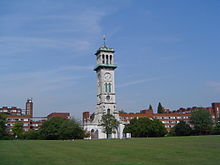- Metropolitan Cattle Market
-
The Metropolitan Cattle Market (later Caledonian Market) in Islington, north London was built by the City of London Corporation and opened in June 1855 by Prince Albert. The market was supplementary to the meat market at Smithfield and was established to remove the difficulty of managing live cattle at that latter site.
The market originally covered 30 acres (0.12 km2) of the site and grounds of Copenhagen House (previously a pleasure resort and tea garden). It occupied most of the land between Hungerford Road and Hartham Road (north), Caledonian Road (east), Brandon Road and Blundell Street (south) and York Way (west) and its construction cost the Corporation £300,000. Market Road, North Road, Shearling Way and Brewery Road were internal roads within the market area.
The site was chosen for its proximity to the goods yards of the newly opened Great North Eastern Railway and North London Railway to the north of Kings Cross station. Livestock could be conveniently transported to the depots before being driven the short distance up York Way to the market or walked down from Junction Road railway station. On market days in excess of 15,000 animals could be traded.
The central market area was arranged in a rectangle with stalls and pens for cattle, sheep and pigs and a 46 metres (151 ft) tall central clock tower. Dealers' offices were arranged in the central area and slaughter houses were close by. The market was enclosed by cast iron railings, the columns of which were topped with cast iron heads of the animals traded. The railings remain but the heads were removed many years ago.
At each of the corners of the main area large market pubs provided accommodation and entertainment for those visiting the market. The pubs were named The Lion, The Lamb, The White Horse and The Black Bull. Today, three of the four remain and, with the clock tower, are listed structures. A fifth pub, The Butchers Arms, built to a similar design was located at the south-west corner of the market site at the junction of York Way and Brewery Road. The building remains.
In the early 20th century, as the trade in live animals diminished, a bric-a-brac market developed which after the Second World War transferred south of the river becoming the New Caledonian or Bermondsey Market. The markets finally closed in 1963.
The northern part of the main market site was redeveloped by the Greater London Council (GLC) as the Market Estate and completed in 1967 to a design by architects Farber & Bartholomew[1]. On the western area where sheep were kept, the Corporation built the York Way Estate to designs by McMorran & Whitby and completed in 1969[1]. The southern area of the market, south of Market Road, where the cattle were kept and where the slaughter houses were is now sports pitches. The rest forms Caledonian Park.
At the break-up of the GLC, Market Estate was transferred to the control of the local authority, London Borough of Islington. After years of poor maintenance and declining social conditions, the estate was transferred to a Registered Social Landlord, Southern Housing in 2005. The whole estate is being regenerated with the original blocks being demolished and replaced with a new layout of streets[1].
References
- ^ a b c Spring, Martin (14 September 2007). "The Writing's on the Wall". Building (London: CMP Information Limited) 2007 (37): pp. 42–47. http://www.building.co.uk/story.asp?sectioncode=583&storycode=3095065. Retrieved 2008-01-03.
External links
Coordinates: 51°32′46″N 0°07′25″W / 51.54618°N 0.12374°W
Markets in London Historic Old Billingsgate • Covent Garden • Cumberland Market • Farringdon • Fleet • Leadenhall • Metropolitan Cattle • Smithfield • Old SpitalfieldsNoted Bermondsey • Borough • Brick Lane • Camden Lock • Camden Passage • Columbia Road • Greenwich • Petticoat Lane • Portobello RoadHistoric charter Barking • Barnet • Croydon (Surrey Street) • Romford • UxbridgeLocal Backyard • Berwick Street • The Blue • Broadway • Brixton • Chapel • Chrisp Street • Deptford • East Street • Edmonton Green • Exmouth • Lower Marsh • Merton Abbey Mills • Queen's • Rathbone • Ridley Road • Shepherd's Bush • Strutton Ground • Sunday UpMarket • WalthamstowModern wholesale Categories:- Former buildings and structures of Islington
- Wholesale markets in London
- Former parks and open spaces of London
Wikimedia Foundation. 2010.



